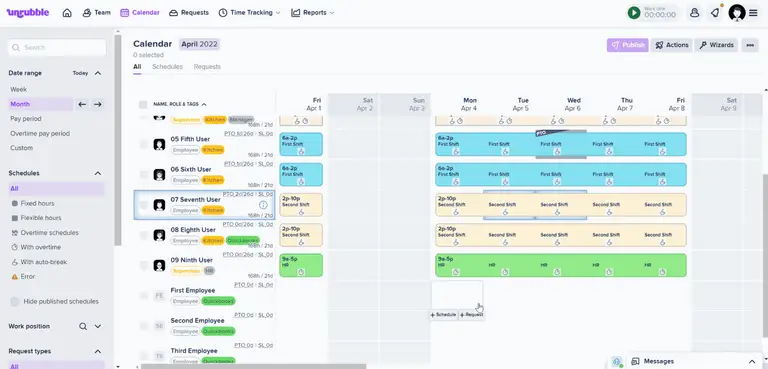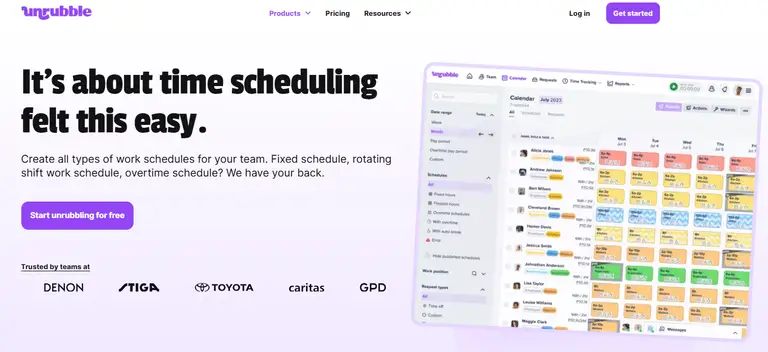Some weeks, it feels like you're spending more time fixing the schedule than running the team. Shifts change, people call in sick, and suddenly managing your staff = fighting fires. Are we right?
Luckily, tools like staff rostering software exist.
But the real question is: do you even need it? Let’s find out.
What is employee rostering software?
Employee rostering software is a tool that helps you schedule shifts and track employee hours. It replaces spreadsheets and sticky notes.
Most employee scheduling apps include features like:
- employee availability,
- shift swaps,
- absence management,
- and even ways to manage overtime.
Some offer flexible roster options or let staff choose preferred shifts. Others sync with payroll or help hit optimal staffing levels based on customer feedback or demand.
In short: it helps you stay organized and cover every shift.
Do you need employee rostering software? Our checklist
Not every business needs it. But many wait too long to admit they do.
This checklist is here to help you figure out where you stand. No matter if you're building the same schedule from scratch every week or struggling to track who’s working, start here.
If you nod your head more than a few times, it might be time to make the switch.
Section 1: what’s your business like?
If you said yes to any of these… you’re probably ready.
Manual workarounds and sticky note shift swaps only get you so far. If your day-to-day includes lost time off requests and chaotic shift edits, it’s not “just part of the job” - it’s a red flag. Your team deserves better. So do you.
- You manage shift schedules or tasks across multiple locations
- You’re handling hourly workers and need better workforce management
- Your employee roster is longer than your grocery list
- You lose track of upcoming shifts, who’s out, who’s late, or who swapped
- You're tired of approving time off requests via sticky notes
- Your team’s availability tracking lives in five different WhatsApp chats
- You’ve tried using spreadsheets to manage schedules, and it’s chaos
- Your team communication happens in 3 apps and a hallway chat
- You're adjusting shifts constantly with no way to track changes
- You’re juggling staff scheduling, sick calls, and shift requests all at once
Section 2: what’s your size?
How many people does it take before a spreadsheet explodes?
There’s a tipping point, and most teams don’t realize they’ve passed it. The moment your headcount outpaces your tools, mistakes multiply fast. Missed shifts and poor availability tracking - it all adds up. And yes, your spreadsheet will betray you.
- 1–4 employees → You’re okay with manual tools (for now)
- 5–15 → Look into scheduling tools before things unravel
- 16–50 → Time to adopt a real workforce management system
- 51+ → Not using tech here is like printing receipts by hand
- You’ve grown over a decade, but your scheduling hasn’t
- You’ve outgrown your existing systems, but haven’t replaced them
Section 3: are you spending hours on this?
If you’re losing sleep over shifts… you need help.
You shouldn’t be stuck in Excel every Sunday night. Building schedules by hand and trying to optimize labor costs with guesswork isn’t sustainable. There are smarter ways to get your hours back, and your weekends too.
- You build work schedules from scratch weekly
- You repeat the same scheduling process for every new shift
- You’ve retyped the same name into a spreadsheet 30 times
- You constantly adjust the team’s schedule last-minute
- You’re stuck resolving scheduling conflicts manually
- You’re wasting time digging into employee timesheets for corrections
- You feel like you’re the only one who understands the system
- You're spending hours trying to optimize labor costs by guessing
Section 4: tech you already use (or don’t)
Spoiler: Google Sheets isn’t a rostering system.
It might have gotten you through year one. But spreadsheets and duct-taped “free tools” can’t track employee time or prevent scheduling conflicts. When your system starts holding you back, it’s time to switch.
- You still print schedules and stick them in the break room
- You’re stuck with a “free” app that locks real features
- You want better employee attendance tracking, but don’t have time to shop around
- You think a time clock is just someone texting “I’m here”
- You haven’t explored HR systems that connect to scheduling
- You don’t trust your current tool to assign shifts accurately
- You’d love something that plays nice with payroll systems
Section 5: what you could be doing instead
What if staff rostering software made all of this go away?
Imagine a world where your schedule writes itself. Where shift requests and payroll exports happen automatically. Where your employee preferences and availability actually shape the schedule. That world exists, and it starts with better software.
- Use an auto scheduling feature that builds shifts for you
- Base shift management on historical data and sales forecasts
- Let employees request shifts or set preferred shifts digitally
- Get smarter equal shift distribution across roles and teams
- Instantly notify staff about open shifts or changes
- Sync hours to payroll, not your head
- Reduce burnout and improve work life balance for your team
- Match shifts to employee preferences and roles
- Rely on labor cost management tools to keep spending in check
Section 6: are your schedules growing with you?
If the team’s growing, your tools should too.
What worked for 5 people won’t cut it for 30. Or 100. If your current setup cracks under complex scheduling, or can’t handle rotating shifts, you’re overdue for an upgrade. Growth is good. And your tools should keep up, not slow you down.
- You’re expanding to new sites or regions
- You’re onboarding contractors, part-time, or seasonal staff
- You’ve started using scheduling templates, but they don’t scale
- You need smarter systems to create schedules that don’t fall apart
- You’re managing complex scheduling across roles, time zones, or teams
- You’re looking for strategic planning support, not just data dumps
Section 7: how is employee communication going?
Because shift planning and team messaging should live together.
If your team needs three apps and a phone call to confirm one shift, it’s already broken. Missed updates and no record of who approved what? That’s how small misunderstandings turn into real problems. Keep it all in one place where it belongs.
- You send shift reminders via group text
- Employees miss updates more than they read them
- You're answering the same shift question 10 times a week
- You have no trail of who approved what and when
- You can’t track or confirm who accepted or declined a shift
- You’re the middleman for every swap shift request
Section 8: are you staying compliant and secure?
It’s not glamorous but it keeps you safe.
Labor laws, payroll disputes - they don’t care if your system was “working fine.” Without proper time tracking software and digital records, you’re risking fines and reputation damage. Good systems prevent bad surprises.
- You don’t document work hours, breaks, or overtime accurately
- Your employee time clock doesn’t verify anything
- You’ve had issues with labor laws or audit readiness
- You don’t store employee attendance data securely
- You lack a clear backup of all your workforce management features
- You’ve had to rely on memory instead of logs more than once
Final verdict: so… do you need it?
Let’s count it up.
If you’ve ticked:
- ✅ 0-5 boxes → You’re in control (for now), but keep watch
- ✅ 6-12 boxes → Things are slipping. Time to start planning
- ✅ 13-20 boxes → You’re losing time, money, and probably sleep
- ✅ 21+ boxes → You’re beyond the tipping point. Get real scheduling software now.
Create employee schedules with Unrubble - the best employee scheduling software
If that checklist stung a little, it’s not your fault.
Schedules get messy fast, especially when you’re managing last-minute call-ins and trying to balance employee availability with actual coverage.
And when everyone’s out of sync, it shows: low team productivity and quiet frustration that no one says out loud.
We built Unrubble for that exact moment. Not for perfect weeks. For real ones.

With Unrubble, it starts with building schedules the smart way. You can use AI-powered planning to auto-generate shifts based on your past patterns and who’s actually available. The Automatic AI Scheduler considers tags and even preferred hours, so you’re not guessing who fits where.
Need full control? You’ve got it. Use the manual planner with wizards to drag, drop, and copy shifts across days or teams. Want to repeat a Monday-Friday 8-4pm shift for five people next month? You can do that in three clicks. Add breaks. Count overtime before or after a shift. Define roles. Publish it. Done.
And once it’s published, your team sees it instantly: from the Employee Self-Service App, not a breakroom wall. They can swap shifts, submit time off requests, or mark when they’re unavailable. Their changes hit your calendar in real time. No more “I told you last week!” drama.
The system also flags conflicts before they go live: someone’s on holiday? Already scheduled elsewhere? Running too close to overtime? You’ll know. It even highlights pending requests and vacations directly in the schedule view, so nothing gets buried.
And yes - when you’re ready, those hours sync straight into payroll. Because that’s what scheduling should do: connect the dots, not scatter them.

So if your current system feels like one more full-time job?
Don’t just fix it. Unrubble it.
👉 Start your free trial No card, no commitment. Simply better scheduling.



![What Does PEO Stand For In HR Administration? [2026 Guide]](/static/image?src=https%3A%2F%2Fcdnblog.unrubble.com%2Fpayload-unrubble-images%2FUnrubble-what-does-peo-stand-for-in-hr-administration-180x120.jpg&width=128&height=128&fit=cover&position=center&quality=65&compressionLevel=9&loop=0&delay=100&crop=null&contentType=image%2Fwebp)



